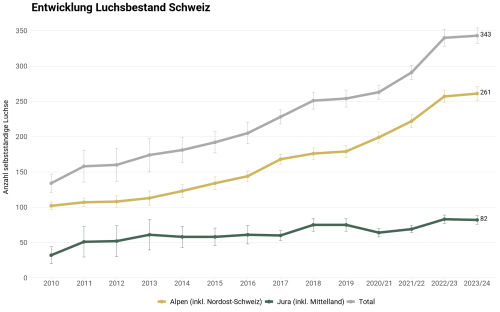- Portrait
- Nachweise im Feld
- Verbreitung
- Bestand
- Fotofallen-Monitoring
- Verluste
- Übergriffe auf Nutztiere
- FAQs
BESTAND
SCHWEIZ
Eine genaue Bestandsangabe zu einem bestimmten Zeitpunkt ist nicht möglich, da das Fotofallen-Monitoring in den Kompartimenten nicht gleichzeitig stattfindet. Die hier gemachte Bestandsschätzung ist eine Extrapolation des jeweils jüngsten Fotofallen-Durchgangs in einem Referenzgebiet auf das gesamte Kompartiment aufgrund der Zufallsbeobachtungen (siehe Methodenteil).
 Entwicklung der Luchspopulation in der Schweiz (2010–2023/24): Ab dem Jahr 2020/21 basiert die Darstellung auf dem biologischen Jahr. Die Erhebungszeiträume erstrecken sich dann jeweils vom 1. Mai des Vorjahres bis zum 30. April des Folgejahres. © KORA
Entwicklung der Luchspopulation in der Schweiz (2010–2023/24): Ab dem Jahr 2020/21 basiert die Darstellung auf dem biologischen Jahr. Die Erhebungszeiträume erstrecken sich dann jeweils vom 1. Mai des Vorjahres bis zum 30. April des Folgejahres. © KORA Entwicklung der Luchspopulation in der Schweiz (2010–2023/24): Ab dem Jahr 2020/21 basiert die Darstellung auf dem biologischen Jahr. Die Erhebungszeiträume erstrecken sich dann jeweils vom 1. Mai des Vorjahres bis zum 30. April des Folgejahres. © KORA
EUROPA
Im Jahr 2024 wurde der Bestand der Eurasischen Luchse in Europa vom LCIE auf wurde eine Gesamtpopulation von 9400 Tieren geschätzt. Die Aufteilung der geschätzten Anzahl Individuen auf die 11 verschiedenen Populationen ist in untenstehender Tabelle dargestellt. Die Population im Balkan bildet eine eigene Unterart und ist vom Aussterben bedroht.
| Population | Länder | Schätzung | Trend |
| Skandinavien | NO, SE | 1820 | Zunahme |
| Karelien | FI | 2483 | Stabil |
| Baltikum | EE, LV, LT, PL, UA | 1555 | Zunahme |
| Karpaten | RO, SK, PL, UA, CZ, HU, RS, BG | 2687 | Zunahme |
| Böhmen-Bayern-Österreich | CZ, DE, AT | 135 | Zunahme |
| Alpen | CH, SI, IT, AT, FR | 255 | Zunahme |
| Jura | CH | mehr als 69 | Leichte Zunahme |
| Vogesen-Pfälzerwald | FR, DE | mehr als 12 | Abnahme |
| Dinariden | SI, HR, BA | 130 | Stabil oder Abnahme |
| Harzgebirge | DE | 46 | Leichte Zunahme |
| Balkan | MK, AL, XK | 34 | Stabil |
| Pommersches Vorkommen | PL | 31 | Zunahme |
| Schwarzwald / Schwäbische Alb | DE | 5 | Unbekannt |

